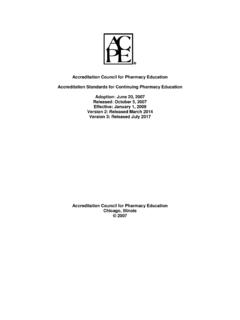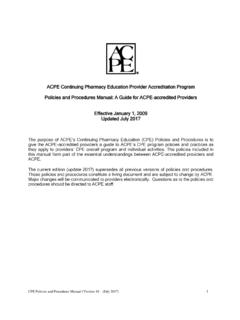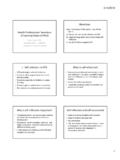Transcription of ACCREDITATION COUNCIL FOR PHARMACY …
1 ACCREDITATION COUNCIL FOR PHARMACY education . ACCREDITATION STANDARDS AND KEY ELEMENTS FOR THE. PROFESSIONAL PROGRAM IN PHARMACY LEADING TO. THE DOCTOR OF PHARMACY DEGREE. ( STANDARDS 2016 ). APPROVED January 25, 2015. RELEASED February 2, 2015. ACCREDITATION COUNCIL for PHARMACY education Chicago, Illinois 2015. TABLE OF CONTENTS. iii SECTION I: EDUCATIONAL OUTCOMES .. 1. Standard 1: Foundational Knowledge .. 1. Standard 2: Essentials for Practice and Care .. 1. Standard 3: Approach to Practice and Care .. 2. Standard 4: Personal and Professional Development .. 2. SECTION II: STRUCTURE AND PROCESS TO PROMOTE. ACHIEVEMENT OF EDUCATIONAL OUTCOMES .. 3. Standard 5: Eligibility and Reporting Requirements .. 3. Standard 6: College or School Vision, Mission, and Goals .. 3. Standard 7: Strategic Plan .. 4. Standard 8: Organization and 4.
2 Standard 9: Organizational Culture .. 5. Standard10: Curriculum Design, Delivery, and Oversight .. 5. Standard 11: interprofessional education (IPE) .. 7. Standard 12: Pre-Advanced PHARMACY Practice Experience (Pre-APPE) Curriculum .. 8. Standard 13: Advanced PHARMACY Practice Experience (APPE) Curriculum .. 9. Standard 14: Student Services .. 10. Standard 15: Academic Environment .. 10. Standard 16: Admissions .. 11. Standard 17: Progression .. 12. Standard 18: Faculty and Staff - Quantitative Factors .. 13. Standard 19: Faculty and Staff - Qualitative 13. Standard 20: Preceptors .. 14. Standard 21: Physical Facilities and Educational Resources .. 15. Standard 22: Practice Facilities .. 15. Standard 23: Financial Resources .. 16. SECTION III: ASSESSMENT OF STANDARDS AND KEY ELEMENTS .. 17. Standard 24: Assessment Elements for Section I: Educational Outcomes.
3 17. Standard 25: Assessment Elements for Section II: Structure and Process .. 17. Appendix 1 .. 19. Required Elements of the Didactic Doctor of PHARMACY Curriculum i Appendix 2 .. 24. Expectations within the APPE Curriculum Appendix 3 .. 26. Required Documentation for Standards and Key Elements 2016. ii ACCREDITATION COUNCIL FOR. PHARMACY education . STANDARDS 2016. PREAMBLE. ACCREDITATION COUNCIL for PHARMACY education (ACPE). The ACCREDITATION COUNCIL for PHARMACY education (ACPE) is the national agency for the ACCREDITATION of professional degree programs in PHARMACY and providers of continuing PHARMACY education . ACPE (until 2003 known as the American COUNCIL on Pharmaceutical education ) was established in 1932 for the ACCREDITATION of professional degree programs in PHARMACY , and in 1975 its scope was broadened to include ACCREDITATION of providers of continuing PHARMACY education ( ).
4 ACPE expanded its activities to include evaluation and certification of professional degree programs internationally in 2011 and entered into a collaboration with the American Society of Health-System Pharmacists (ASHP) to accredit PHARMACY technician education and training programs beginning in 2014. The mission of ACPE is to assure and advance quality in PHARMACY education . ACPE is an autonomous and independent agency whose Board of Directors is appointed by the American Association of Colleges of PHARMACY (AACP), the American Pharmacists Association (APhA), the National Association of Boards of PHARMACY (NABP) (three appointments each), and the American COUNCIL on education (ACE) (one appointment). Since the inception of its ACCREDITATION agency recognition program in 1952, the Department of education (USDE) has continuously recognized ACPE.
5 ACPE also gained recognition by the COUNCIL for Higher education ACCREDITATION (CHEA) in April 2004. State boards of PHARMACY require that licensure applicants from the United States have graduated from an accredited PHARMACY degree program to be eligible to sit for the North American Pharmacist Licensure ExaminationTM (NAPLEX ). Importance of Standards To achieve and maintain ACPE ACCREDITATION , professional Doctor of PHARMACY (PharmD). degree programs (hereafter described as programs') must meet the standards contained in this document. ACPE standards are minimum requirements, and it is expected that programs will exceed these required standards through initiatives designed to ensure continuous quality improvement. These standards describe the various elements needed for quality-assured professional education and are based on evidence and experience.
6 They articulate expectations that ACPE (as well as PHARMACY practice and the PHARMACY academy) has of academic institutions offering the PharmD degree. ACPE standards also reflect the expectations that the Department of education and state boards of PHARMACY have of the colleges and schools, and of ACPE, regarding the quality of professional degree programs. These standards have been developed with input from a broad range of constituents interested in and affected by PHARMACY education . They focus on the educational outcomes required of PharmD programs and the assessment of those outcomes. They also address the structural and process-related elements within PHARMACY education necessary to implement evidence- based outcome measures that document achievement of the standards. In addition, these standards describe areas where programs can experiment and innovate within the didactic and experiential components of their curricula to meet the required Educational Outcomes (Standards 1 4).
7 Establishing a commitment to continuing professional development (CPD) by iii students and graduates is also addressed, as are contemporary educational concepts such student readiness to: Enter advanced PHARMACY practice experiences (APPE-ready). Provide direct patient care in a variety of healthcare settings (Practice-ready). Contribute as a member of an interprofessional collaborative patient care team (Team- ready). Revision of Standards: Background All accrediting bodies, including ACPE, periodically review and revise their standards. A number of environmental factors prompted ACPE to conduct a careful reassessment of the standards. These factors included: The experience gained by ACPE in its ACCREDITATION reviews since the adoption of the Doctor of PHARMACY standards in 2007. Feedback from ACPE stakeholders regarding quality improvement of the standards The reports of the Institute of Medicine (IOM) ( ) noting needed changes in our healthcare system to improve medication safety and patient outcomes, including the five competencies that all healthcare professionals should attain during their education : Provide patient-centered care Work in interprofessional teams Employ evidence-based practice Apply quality improvement Utilize informatics Expansion of the scope of PHARMACY practice in state laws and regulations to include collaborative practice with prescribers The revision of the AACP's Center for the Advancement of PHARMACY education (CAPE).
8 Educational Outcomes in 2013, which are intended to be the target toward which the evolving PHARMACY curriculum should be aimed The Joint Commission of PHARMACY Practitioners' (JCPP) Vision of PHARMACY Practice, accepted by the governing boards of 10 PHARMACY organizations, including ACPE, and released in 2013. The document Pharmacists' Patient Care Process, developed by a work group from 11. national PHARMACY organizations to promote a consistent approach to the process of care. This document was endorsed by the Joint Commission of PHARMACY Practitioners in 2014. Health Professionals for a New Century: Transforming education to strengthen health systems in an interdependent world (10)61854-5/fulltext iv Core Competencies for interprofessional Collaborative Practice Revised NAPLEX Competency Statements Revision of Standards: Process Employed In January 2012, ACPE announced to its stakeholders (including PHARMACY colleges and schools, professional PHARMACY organizations, student pharmacist organizations, and other accrediting bodies) its intent to revise the Doctor of PHARMACY degree standards.
9 Written comments were solicited from stakeholders, and many were received. In addition, a Web-based survey that allowed anonymous completion was distributed to all the college or school of PHARMACY deans. ACPE also held a multi-stakeholder invitational conference in fall, 2012 1 to discuss issues facing PHARMACY practice and education . The results of the conference influenced the direction and content of these revised standards. The first draft of the revised standards was approved by the ACPE Board of Directors in January 2014 and distributed to ACPE stakeholders in February 2014. Subsequently, a series of open hearings was conducted at national PHARMACY meetings. Another Web-based survey that allowed anonymous completion by stakeholders was conducted during 2014, and an extensive review of the draft standards was completed by an advisory group from various sections of the academic and practice communities.
10 The ACPE Board of Directors approved the revised standards on January 21 25, 2015 with an effective date of July 1, 2016. The new standards will be referred to as Standards 2016. Colleges and schools being evaluated by ACPE beginning in the fall of 2016 must comply with the new standards. Revision of Standards: What's Different? Format The standards revision process yielded two distinct documents: Standards and Guidance. The Standards document includes the 25 standards, required (key). elements, assessment elements, and required documentation for each individual standard. The Guidance document was developed to support colleges' and schools'. efforts to enhance the quality of their PharmD programs and includes suggested strategies, additional examples of compliance evidence, and other important information to facilitate meeting standards.









